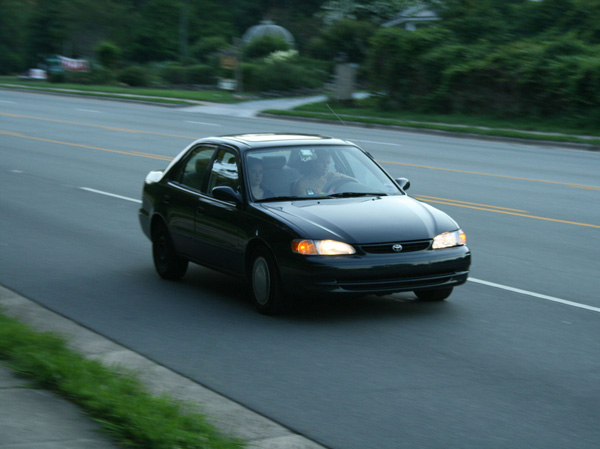- La Feria Native Soon To Retire From The Military This Summer
- Senior Eneece Avila Takes Pride in her State Title
- Dr. Noemi Infante, Harlingen Medical Center Open New Women’s Clinic
- Santa Rosa Cameron County Park Partially Reopens
- Santa Rosa Takes to Regionals Meet in Kingsville, Tx
- Long-Standing Nexstar Tower in La Feria Decommissioned
- Lionettes Powerlifting Meet
- Local Business Holds Event to Benefit RGV Shriners Club
- Knights of Columbus Holds it’s 30th Annual Golf Tournament
- KGBT Tower Dismantled
Turn Signal Neglect a Serious Safety Issue
- Updated: February 12, 2016
Drivers failing to use their blinker more dangerous than distracted drivers
by Cayetano Garza Jr./LFN
It never fails. Not a day goes by that I don’t encounter a driver on the road failing to use their turning signal and it is infuriating!
“Remember to signal your intentions to the other drivers,” my father would always say when he was teaching me how to drive as a teenager. He put a lot of emphasis on using a turning signal and the younger me took it to heart.
“The other people on the road can’t read your mind, son!” he’d say.
His words always go though my mind every time I encounter someone on the road being completely inconsiderate of those around them and failing to “signal their intentions”.
In April of 2012 the Society of Automotive Engineers (SAE) conducted a study that concluded 25 percent of drivers neglect to properly utilize their turn signals when turning, while 48 percent of drivers fail to do so when changing lanes.
The U.S. Department of Transportation reports approximately 950,000 automobile accidents per year are the result of distracted or inattentive drivers, while the SAE reported two million crashes per year are the direct result of turn signal neglect.

With 48 percent of drivers failing to signal a lane change, you’re bound to run into someone at least once a day. Photo: Ildar Sagdejev/Wikicommons.
The SAE surveyed 12,000 lane-changing and turning vehicles.
“This is a first of its kind report on a subject that, amazingly, has never been studied,” said Richard Ponziani, president of RLP Engineering and author of the report.
Despite the fact that using a turning signal is simple, ubiquitous and “extremely effective” there is an epidemic lack of compliance even though “all drivers have an ongoing duty to use them, just as they have a duty to stop at a stop sign or at a red light.”
What is even more telling are some of the excuses people give for not using their turn signals! According to a November 2014 report in the Huffington Post people don’t use turning signals because:
- They forget to turn on their signal
- They don’t have enough time
- They just need to make a lane change or turn instantly
- They think turn signals are optional
- They want to quickly slip into a lane before anyone blocks their access
- Their turn signal is broken
- They are lazy
According to Sec. 545.104 of the Texas Transportation Code when signaling turns and/or using turn signals, “(a) An operator shall use the signal authorized by Section 545.106 to indicate an intention to turn, change lanes, or start from a parked position. (b) An operator intending to turn a vehicle right or left shall signal continuously for not less than the last 100 feet of movement of the vehicle before the turn.”
Interestingly, the 100 foot requirement only applies to turns and not lane changes. Although you are required to signal your intent to change lanes, the law is silent on how long before the lane change your signal must be given.
Anecdotal evidence suggests that police put little effort into enforcement, less than they devote to preventing speeding, distracted driving or the running of stop signs and red lights. However it should be noted that failure to signal a turn in Texas can lead to a Class C Misdemeanor with fines up to $500.
Other than shifting priorities, the 2012 study suggested a technological alternative – the “Smart Turn Signal.”
They “are the perfect complement to the Stability Control System since Stability Control predominately prevents single-vehicle crashes, whereas the Smart Turn Signal prevents multi-vehicle crashes,” suggested Ponziani.
Such a system would automatically shut off a turn signal, likely by timing out after a set delay or by detecting when a vehicle has finished changing lanes – much as today’s cars automatically cancel the signals after making a turn at an intersection.
For those who simply can’t be bothered to use their signals, the system would work much like a seatbelt reminder. It would sense if drivers routinely ignore their turn signals and start to flash a “friendly” reminder.
Using the latest electronics, a Smart Turn Signal system would actually be simpler and less expensive than the current mechanical trip mechanism used for turning, according to Ponziani, concluding that, “This breakthrough represents a perfect opportunity to significantly reduce multi-vehicle crash rates, reduce vehicle cost and make driving a lot more friendly and courteous across the U.S.”
Until such an elegant technological solution becomes a standard in all vehicles, here’s a few tips to keep in mind:
- Get into the habit of signaling every time you change direction. Signal even when you do not see anyone else around. It’s easy to miss someone who needs to know what you are doing.
- Signal as early as you can. Try and signal at least three seconds before you make your move. You must signal at least 100 feet before a turn if the speed limit is 45 mph or less. If the speed limit is faster than 45 mph, you must signal at least 300 feet before you turn.
- Be careful that you do not signal too early. If there are streets, driveways or entrances between you and where you want to turn, wait until you have passed them to signal.
- If another vehicle is about to enter the street between you and where you plan to turn, wait until you have passed it to signal your turn. If you signal earlier, the other driver may think you plan to turn where that driver is and he or she might pull into your path.
- After you have made a turn or lane change, make sure your turn signal is off. After short turns, the signals may not turn off by themselves. Turn it off if it has not canceled by itself. If you do not, other drivers might think you plan to turn again.
ALWAYS SIGNAL when you are going to:
- Change lanes.
- Make a turn.
- Pull away from a parking space which is parallel to the curb.
- Slow down or stop.
You can find more information in the Texas Department of Public Safety Texas Drivers Handbook.
As the number of drivers who neglect to use their turning signals or are distracted while driving go up it is important that those of us that know better be as conscientious as possible. Be courteous to your fellow drivers on the road and try to remember to signal your intentions.






